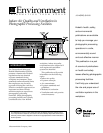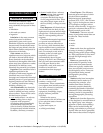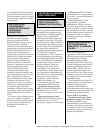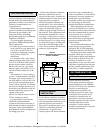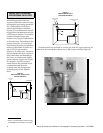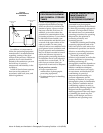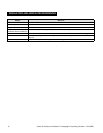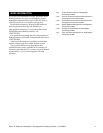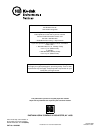
Indoor Air Quality and Ventilation in Photographic Processing Facilities • J-314(ENG) 3
• chronic health effects—adverse
effects resulting from repeated
low level exposure, with
symptoms that develop slowly
over a long period of time. These
may affect target organs such as
the liver, kidney, or lungs or cause
cancer.
Dose Response: All chemicals are
toxic if taken into the body by the
right route of exposure and at a high
enough dose. As the dose increases,
there is a corresponding effect or
response.
Chemicals that require large doses
or exposure concentrations to
produce an adverse effect have a
low toxicity, while chemicals that
require smaller doses to produce an
adverse effect are considered more
toxic. For example, acetic acid is
irritating to the eyes and upper
respiratory system at low
concentrations, about 10 ppm.
Isopropyl alcohol is not irritating to
the eyes until concentrations reach
over 400 ppm. Based on this
comparison, acetic acid causes an
irritation at much lower
concentrations than isopropyl
alcohol.
The air within buildings usually
contains a variety of air
contaminants. These contaminants
can originate from outside sources
(car/truck exhaust) or emissions
from inside sources (office
equipment, furnishings, carpet,
people, kitchens, janitorial
activities).
Whatever the source,
contaminants in the air fall into one
of two physical states of matter.
They are either:
• gases and vapors, or
• solids (particulates)
AIR CONTAMINANTS
In a work environment where
chemicals are used, an individual
may potentially be exposed in three
ways:
• inhalation
• skin and eye contact
• ingestion
Inhalation is the most common
route of exposure for airborne
particulates, gases, and vapors.
Inhalation exposures are important
because many chemicals that enter
the lungs can pass directly into the
blood stream and be transported to
other areas of the body.
Skin contact can also be a
significant source of exposure which
can lead to adverse health effects.
Some chemicals can be absorbed
into the body through the skin while
others may cause irritation or rashes
(dermatitis). In addition, some
chemicals are potential eye irritants.
Ingestion is not considered to be a
significant problem in the
workplace. Inadvertent ingestion of
chemicals may occur if food or
beverages are consumed in chemical
handling areas or if good personal
hygiene practices are not followed,
i.e., washing hands before eating,
drinking, smoking, etc.
Air contaminants: are chemicals
that may be present in the air that
could be inhaled and may produce
adverse effects. These effects can be
divided into two classes:
• acute
health effects—an adverse
effect resulting from a single
exposure with symptoms
developing almost immediately
or shortly after exposure; the
effect is usually of short duration.
Symptoms may include irritation,
headache, dizziness, or nausea.
EXPOSURE CONCEPTS
ROUTES OF EXPOSURE
Gases/Vapors: The difference
between gases and vapors is their
physical state at standard
temperature and atmospheric
pressure (STP, 22.5°C, and 760 mm
Hg). A gas is in the gaseous state at
STP (examples: nitrogen, carbon
dioxide, sulfur dioxide). A vapor is a
gas from a substance that at STP is a
liquid (example, acetic acid).
Particulates: There are several
forms of particulate matter that can
be airborne. These include:
• dust
• fumes
• smoke
• mists
Dust results from the application
of energy to matter, by grinding,
sifting pouring solids, paper cutting,
etc. Dust particles have to be small
enough and light enough to be
airborne.
Fumes are generated by the
condensation of particles in the
vapor state from heated metals.
Fumes are typically smaller than
dust, more soluble, and are more
physiologically active. Fumes are
not generated during normal
photographic processing
operations.
Smoke results from incomplete
combustion and is made up of
extremely fine particles, even
smaller than fumes. Smoke is
extremely complex chemically,
containing thousands of chemical
substances. Unless something is
burning, smoke is not generated
during photographic processing
operations.
Mists result from the dispersion
of fine droplets by aerosolization of
any liquid (spray cans, nitrogen
agitation of tanks, electroplating).
Mists can be formed during the
mixing, recirculation or pouring of
liquids. Mist can also be generated
from foam on the surface of a liquid.



